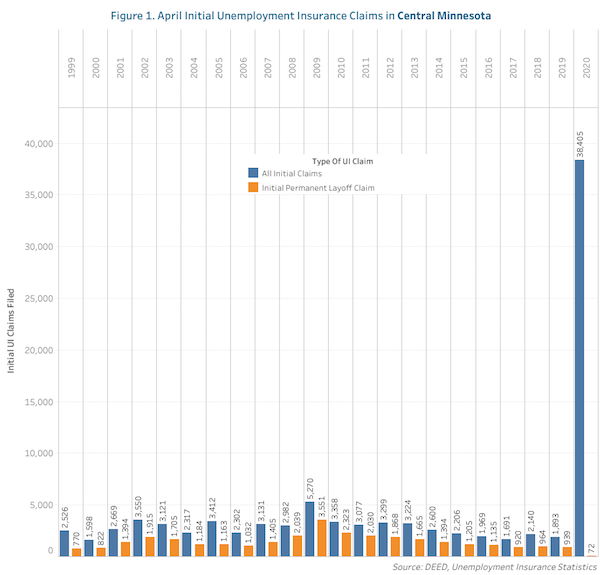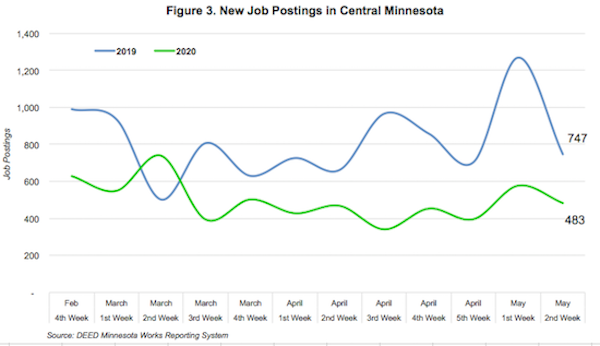
by Luke Greiner
June 2020
The coronavirus pandemic that spread across the nation and state in March and April of 2020 put a halt to the longest running economic expansion in recent history. Statewide, more than 660,000 workers had filed applications for Unemployment Insurance (UI) in Minnesota from March 16 to May 16, with specific demographics, geographies and industries more affected than others. To put the recent economic events into context, DEED has provided a set of articles explaining the impact in each region.
With the global economy suffering a sudden and unexpected negative shock from the COVID-19 pandemic, Central Minnesota's economy could not escape the virus – or the fallout from efforts to slow its spread. Faring just slightly better than the state in terms of Unemployment Insurance (UI) applications as a percentage of the total labor force, the economic impact has been difficult to fathom and not shared equally. From March 16 through May 16 more than 76,700 workers in Central Minnesota have applied for UI, the equivalent of one in every five workers.
The extraordinary nature of the pandemic and the impact of the policies to combat it are clearly shown in the data in Figure 1. Initial UI claims in April for Central Minnesota have averaged 2,778 over the previous decade, even including the peak of 5,270 claims in 2009 during the Great Recession. In April of 2020, there were 38,405 claims. For context, that's 1,262% over the historical norm, and a staggering 1,929% over the previous April. In addition to the astonishing amount of claims filed in April, another 35,060 claims were filed in March, a 1,062% increase over the 10-year average.

While whites made up 93.8% of the labor force in the region, they accounted for just 84.3% of UI applications through May 16. This means that layoff activity has been more concentrated among People of Color within the region, and for two groups in particular. Just over half of Black or African American workers and 44% of American Indian workers have applied for unemployment – more than two and a half times the rate for whites. Likewise, about 30% of Asian or Pacific Islanders and over 22% of workers of Hispanic or Latino origin submitted a UI application through May 16 (see Table 1). These adverse impacts on People of Color could deepen the economic disparities already present in the region.
Table 1. Central Minnesota Unemployment Insurance Applicants by Race, Mar. 16-May 16| Race | Cumulative UI Applications through May 16 | Share of UI Applications | Total Labor Force | Share of Total Labor Force | UI Applications as a Share of Total Labor Force |
|---|---|---|---|---|---|
| White Alone | 67,720 | 84.3% | 360,556 | 93.8% | 18.8% |
| Black or African American | 4,269 | 5.3% | 8,052 | 2.1% | 53.0% |
| American Indian/Alaska Native | 734 | 0.9% | 1,657 | 0.4% | 44.3% |
| Asian or Pacific Islanders | 1,530 | 1.9% | 5,213 | 1.4% | 29.3% |
| Some Other Race and Two or More Races | 1,190 | 1.5% | 8,765 | 2.3% | 13.6% |
| Choose not to answer | 2,323 | 2.9% | N/A | N/A | N/A |
| Hispanic or Latino | 2,612 | 3.2% | 11,667 | 3.0% | 22.4% |
| Total | 80,375 | 100.0% | 384,243 | 100.0% | 20.9% |
| Source: DEED Unemployment Insurance Statistics, 2014-2018 American Community Survey 5-Year Estimates | |||||
About half of all UI claims are typically considered temporary during economic expansions, with a larger share becoming permanent as economic conditions worsen. During the height of the Great Recession in 2009, about 40% were characterized as temporary layoffs. However, 99% of initial UI claims in April in Central Minnesota were for temporary layoffs, an indication of just how different this economic crisis is compared to the last one. While it's likely that not all businesses will be able to withstand the effects of the pandemic, the extent of layoffs first considered temporary that will become permanent is not yet known.
The increase in UI applications appear to be mostly the result of restricted business operations under the Stay at Home and temporary closure orders. As employers were ordered to cease certain functions, many had no choice but to start laying off workers. However, policy and national stimulus interventions changed the way some employers were able to respond. For example, the U.S. Small Business Administration Payroll Protection Program (PPP) encouraged employers to keep workers on their payroll with the promise of forgivable loans if workers remained connected to employers. The PPP could cause significant shifts in UI data as they play out.
The chances of being laid off as a result of the pandemic containment measures are largely dependent on the type of occupation workers are in. Food preparation and serving occupations accounted for the largest share of claims in Central Minnesota, with 10,676 claims filed for various occupations within the field. For perspective, that's just over 70% of total employment for the occupation group. Over half of the food preparation and serving claims were from food and beverage serving workers (5,709 UI claims) such as waiters and waitresses, bartenders, and fast food workers. Likewise, when the retail trade sector began closing doors, retail sales workers filed over 4,500 UI claims in Central Minnesota, along with more than 2,000 sales representatives and other types of sales workers.
When elective surgeries were put on hold, many health care establishments were forced to begin laying off health care workers. Health care support occupations had 27.5% of employment laid off, with big losses in occupations such as massage therapists, dental and medical assistants, dentists, medical equipment preparers and transcriptionists. However, higher level health care workers - such as pharmacists, physicians, RN's, paramedics - fared better, with only about 20% of those workers filing UI claims since March 16.
Overall, new claims have dropped substantially (-67%) between April 11 and May 16. One troubling exception is claims from production workers. Many manufacturing sectors were deemed critical and were allowed to continue operating throughout the pandemic. However a spike in claims occurred during April and has remained elevated, even increasing slightly during the first three weeks of May. Anecdotally, a share of the claims from production workers are the result of large animal processing plants temporarily shuttering operations in order to implement COVID-19 safety measures (see Figure 2).
Despite a downturn in economic conditions that occurred more sharply than we have seen in modern times, opportunities persist for job seekers. MinnesotaWorks.net, the state’s online labor exchange tool where employers can post open positions and review posted resumes and job seekers can post resumes and search job postings, provides insight of the labor market through the pandemic (see Figure 3).

From March 15 through May 16, Central Minnesota employers posted 4,042 jobs openings on MinnesotaWorks.net, which was about half as many openings as the same period last year (7,369 postings). Interestingly, the number of openings being posted in the region was already lower than last year well before any measures to slow the spread of COVID-19 were implemented. In fact, job postings in Central Minnesota during the 4 quarter of 2019 were down 27% from the 4th quarter of 2018. It appears that labor market had loosened a bit in the months before the pandemic.
That being said, current conditions are still providing opportunities for job seekers, with nearly 500 new openings in the most recent week for which data is available. However, new postings from March through the second week of May have an unusually high share that are for temporary help, accounting for 23% of all openings in the region, more than double the share a year ago (11.7%).
In conclusion, the effects of the COVID-19 pandemic and efforts to slow the spread of the virus are likely to have lasting impacts, but the most negative effects are being concentrated in certain industries and the occupations they employ. Workers in retail sales and food and beverage serving occupations are filing a disproportionate number of claims, but so far the vast majority of layoffs are considered temporary.